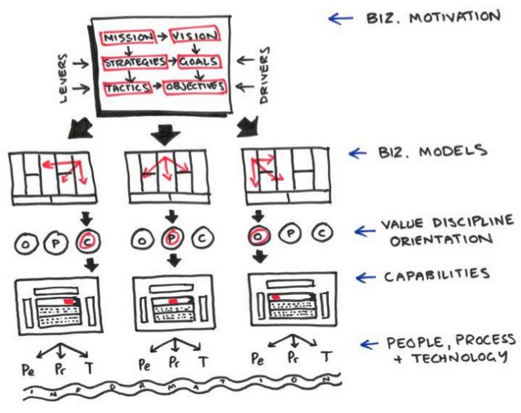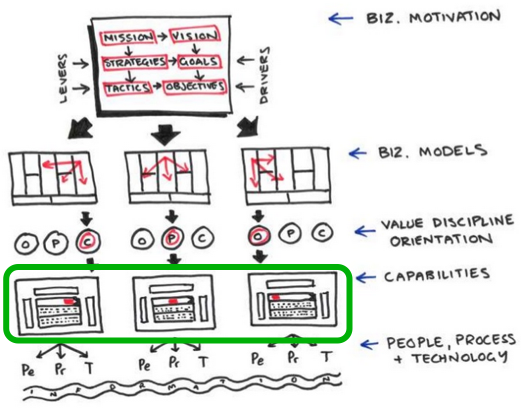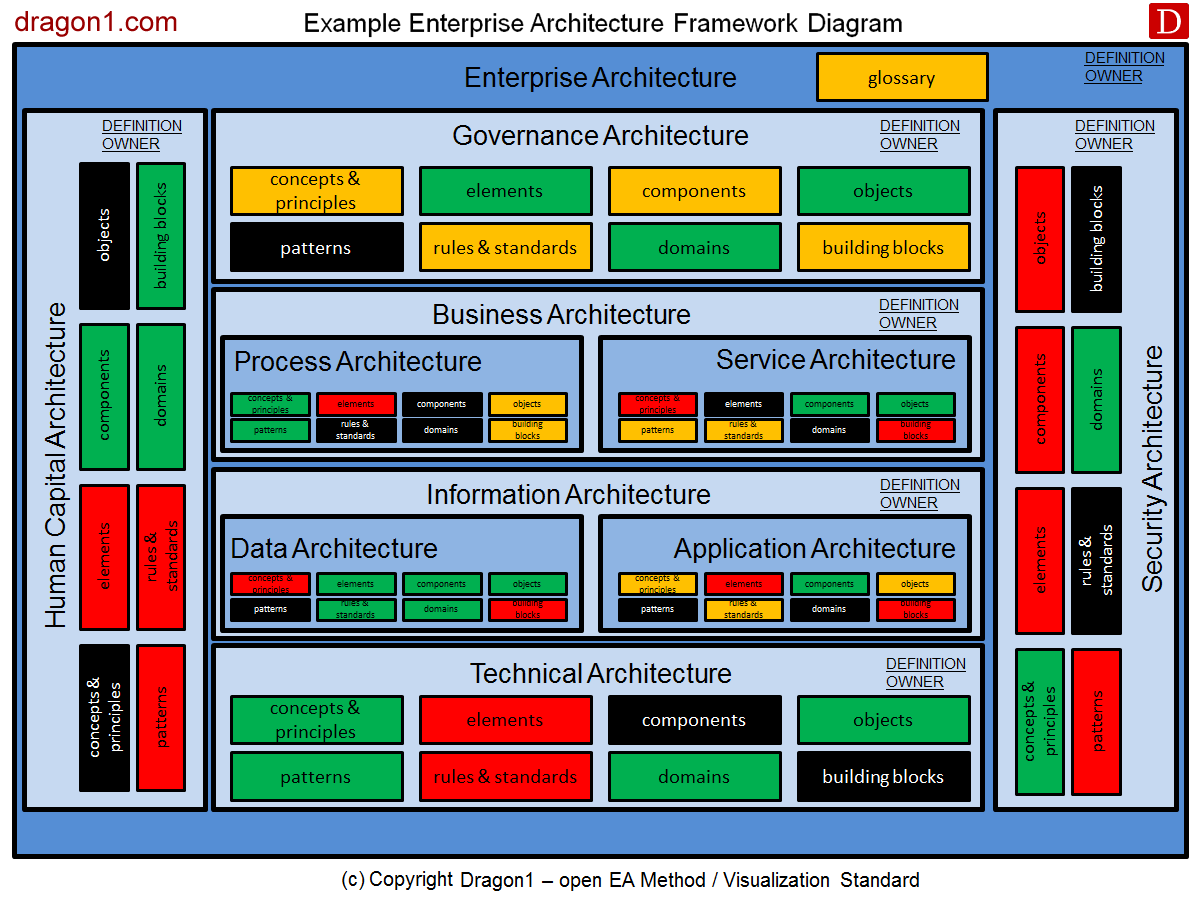Enterprise Architecture in Spain. ------------------------------------------------------------------------------------------------------- Arquitectura Empresarial en España. ---------------------------------------------------------------------------------------------------- A collection of EA things (post, twits, files, blogs...) I find on the internet (TOGAF, Zachman, PEAF, FEAF, Gartner ...)
sábado, 31 de mayo de 2014
jueves, 29 de mayo de 2014
miércoles, 28 de mayo de 2014
Business Architecture Quick Start
Business architecture is not just one more approach or technique; it is a shift in philosophy. In organizations where business architecture is embraced, the role of strategic visioning, issue analysis and transformation planning is shifted to the business. When the business takes ownership of the business vocabulary and accompanying views, the organization can break free of the silo-oriented shackles that curtail strategic planning, visioning, and funding, and obstruct initiative deployment.
Business Architecture Benefits
Business architecture allows business professionals to drive key initiatives based on a rich, comprehensive understanding of the business environment. And just as important, business architecture provides IT with a unique and powerful collaboration opportunity that does not exist without it. Building a business architecture for your organization will:
-
Deliver transparency and clarity to enable issue analysis and resolution
-
Provide business professionals with a common vocabulary that can be used to perform root cause analysis, establish priorities and articulate requirements to a wide variety of stakeholders
-
Provide a holistic view of the business - one that extends into outsourcing, customer and other related stakeholder domains
-
Make it possible for the business to take ownership of and drive transformation strategies from a business (not technology) perspective
-
Enable laser-like investment focus on essential business capabilities, information requirements and value streams
Building Your Business Architecture
The steps to building a business architecture are clear:
-
Establish goals, team and governance
-
Define, socialize and refine capability map
-
Define priority value streams
-
Define information asset definitions
-
Create organization, capability, information and value stream mapping
-
Align and leverage business architecture within priority business initiatives
Rolling out this roadmap, however, is not easy to do without independent support. Cutter Consortium provides just that. Cutter's team of experts has developed and proven the Business Architecture Quick Start approach to assisting companies build their business architecture.
Cutter's Delivery Approach
The journey towards building the business architecture is as important as the destination. The true value of business architecture is only achieved when a company owns and builds the business architecture itself; therefore, the business architecture building exercise is done by your organization and not by Cutter. Cutter's role is to mentor, advise and facilitate your business architecture efforts. By taking ownership of the effort, your organization will more readily embrace the business architecture philosophy and use the resultant "living blueprint" to deliver value by enabling a wide range of cross-functional, cross-disciplinary business initiatives. Cutter's Business Architecture Quick Start team will:
-
Provide you with clear direction through a 2-day Kickoff Workshop and working session
-
Mentor a 2-4 week intensive Roadmap drafting exercise
-
Mentor and provide advisory services for 8-12 weeks to move the business architecture forward
Plus, Cutter will help your team deliver:
-
A foundational capability map for the business
-
A view of core business Value Streams
-
Definitions for key information assets tied to core/customer-facing capabilities
-
An organization mapping approach
-
Initial samples of a business visioning exercise using the business architecture
-
Suggested steps for mapping business architecture to IT architecture
-
Approach for developing a business-driven transformation roadmap
Business architecture enables organizations to deliver a wide range of tactical and strategic business scenarios. Cutter's Business Architecture Quick Start engagement gives you the support you need to take advantage of the opportunity. To schedule your Quick Start, or for more information, contact your Cutter Consortium Account Executive by phone at +1 781 648 8700 or email sales@cutter.com.
martes, 27 de mayo de 2014
The Role of Solution Architect
Table 1 -- Comparison of Solution and Enterprise Architects
Topic
Solution Architecture
Enterprise Architecture
Scope
Single solution or set of related solutions
All current and future solutions and COTS
Primary Goals
Ensure that the solution fits within the enterprise context
Define the enterprise context including business, information, application, and technology
Responsibility
Translates nonfunctional and functional requirements into design, within enterprise context
Translates strategies into target architectures and roadmaps
Tradeoffs
Enterprise strategy and goals vs. solution tactical and delivery requirements
Prioritization and rationalization of conflicting business, information, and technology requirements
Primary Artifacts
Solutions architectures and designs
Enterprise reference architectures, patterns and standards
Primary Stakeholders
Solutions owners, EA, development team, technology
Executive leadership, business leaders, CIO, solutions
Characteristics
Credibility with solutions teams and owners
Broad knowledge and experience, vision
Skills
Conceptualization, patterns, modeling, design, communications
Contextualization, conceptualization, abstraction, modeling, communications
Reporting Structure
Assigned to and functions as part of solution team; may report to solution owner or line of business, development, or EA
Reports to EA team, typically part of CIO organization
domingo, 25 de mayo de 2014
viernes, 23 de mayo de 2014
miércoles, 21 de mayo de 2014
Positioning Enterprise Canvas in enterprise-architecture work
http://weblog.tetradian.com/2013/10/15/positioning-ecanvas-in-ea-work/
http://weblog.tomgraves.org/2011/07/26/from-biz-model-to-ea/
http://weblog.tetradian.com/2011/07/26/bmcanvas-to-archimate-short/


- Biz. Motivation: use Nick Malik‘s Enterprise Business Motivation Model (EBMM)
- Biz. Models: use Alex Osterwalder’s Business Model Canvas (BMC)
- Value Discipline Orientation: use the three orientations (‘Operational-excellence’, ‘Product-leadership’ and ‘Customer-intimacy’) to select an emphasis and orientation in a respective service to be modelled in Enterprise Canvas – typically:
- ‘Operational-excellence’: emphasis on combination of supplier-facing (left-side) and self (centre) in Enterprise Canvas
- ‘Product-leadership’: emphasis on self (centre) in Enterprise Canvas
- ‘Customer-intimacy’: emphasis on customer-facing (‘right-side) in Enterprise Canvas
- Capabilities: model as services in Enterprise Canvas, perhaps using a translation via Archimate, such as described in the post ‘From business-model to enterprise-architecture‘, or more briefly in the post ‘Business Model Canvas to Archimate (the short version)‘
- People, Process + Technology: translate downward from Enterprise Canvas into UML,BPMN or other notations, as required
lunes, 19 de mayo de 2014
Microsoft Architecture Resources
domingo, 18 de mayo de 2014
sábado, 17 de mayo de 2014
jueves, 15 de mayo de 2014
martes, 13 de mayo de 2014
PARTICIPATE IN THE BABOK® GUIDE V3 PUBLIC
PARTICIPATE IN THE BABOK® GUIDE V3 PUBLIC REVIEW
REVIEWhttp://www.iiba.org/babok-guide-v3-public-review/index.html
lunes, 12 de mayo de 2014
domingo, 11 de mayo de 2014
An enterprise architect’s view of capability maps
http://ashridgeonoperatingmodels.com/2014/05/01/an-enterprise-architects-view-of-capability-maps/
http://enterprisearchitects.com/business-function-does-it-have-a-place-in-business-architecture/
I would personally prefer to define a capability as a grouping of organisational resources or assets (i.e., people, information, tools) and processes, necessary to deliver one or more strategic objectives.
viernes, 9 de mayo de 2014
Enterprise architecture as a capability
Enterprise architecture as a capability
http://www.slideshare.net/Uppalj/enterprise-architecture-as-a-capability
miércoles, 7 de mayo de 2014
martes, 6 de mayo de 2014
lunes, 5 de mayo de 2014
How to revamp an IT department for better business
http://www.it-director.com/enterprise/technology/content.php?cid=14454
How to revamp your IT operational plan without getting fired
domingo, 4 de mayo de 2014
jueves, 1 de mayo de 2014
Strategy & Roadmap Specialist / Business Architect Lead
Our client has a direct Hire position open for a Strategy & Roadmap Specialist / Business Architect Lead.
Excellent Relocation and Benefits on the offer.
The Strategy & Roadmap / Business Architect Lead role is directly responsible for future state planning and overall business architecture.
Architects are responsible for: (1) Understanding the holistic view of the environment and their dependencies. (2) Future State Planning (3) Research & Development (4) Architecture Principles (5) Technology Standards (6) Architecture Governance.
Project:
The Strategy & Roadmap / Business Architect Lead role is responsible for establishing and leading the approach (templates, processes, etc.) for creation of technology strategies and roadmaps at Company. Additionally, this role is responsible for leading a team of matrix aligned Business Architect resources to establish and maintain a cohesive business architecture for Company.
Manage Enterprise Architecture Roadmap Process
Ensure each Roadmap has the appropriate targets and they are validated against business objectives for that area
Provide the transparency and visibility of progress of roadmaps based on the objectives
Coordinating and ensure annual working sessions take place for each roadmap to add, change or remove initiatives
Work closely with other EA resources to prioritize initiatives and determine the placement in the roadmap
Facilitate assessments that can be requested on any architecture discipline, Information Systems, Information Technology, Data, and Solution.
Please email your resume to: peter@enterprise-logic.com
Able to advocate the importance/ benefits of EA roadmap implementation to all levels of the organization. Present the results of the initiative implementations on a periodic basis.
This role will work closely with Business Partners and IT Senior Managers to understand business and technical changes that may affect the roadmap
Experience in leadership role developing IT corporate strategies
Well versed in enterprise architecture/IT Strategies
Possess strong business acumen and aptitude to understand the key business drivers and financial knowledge to development return on investment models.
This role is the primary liaison between the EA Team to the PMO
Lead a team of matrix aligned Business Architects, compiling their line-of-business architectures into an overall cohesive business architecture for Company
Analyze enterprise business context (trends and business strategy), as well as change requirements in other enterprise architecture (EA) viewpoints, to derive the future state. This includes defining the requirements, and models that guide technology decisions for the enterprise.
Define high-level migration plans to address the gaps between the current and future state.
Assist with designing the governance activities associated with ensuring compliance.
Define metrics to measure and demonstrate value.
Understand and advocate EA principles and be prepared to "sell" the EA process, its outcome and ongoing results.
Strong relationship building skills to effectively work in all areas of the business to successfully perform the required duties
Lead enterprise level technology adoption resulting in the successful development and implementation of technology roadmaps for large, enterprise-wide technology transformation initiatives.
This role will report directly to the EA Director.
Tasks:
Works with substantial latitude and is often involved in matters which have a major bearing on the Company’s business.
Often handles multiple assignments concurrently, leveraging experience and advanced skill in handling complex assignments with no supervision necessary.
Develops and maintains credibility and effective working relationships with both Business Partner management and IT personnel in a way that demonstrates an understanding of business problems, IT strategies, issues, and priorities.
Participates in development and implementation of strategies to meet organizational goals, ensuring that client and BTS priorities are aligned and accomplished.
Examples of knowledge areas include...
Architecture Assessment Approach
The Enterprise Architecture Roadmap Process and Toolkit
Business Risk Management
Risk/Return Analysis
Information Security Management
IT Risk Assessment
IT Risk Management
IT Security Management
IT Standards, Procedures, and Policies Formulation
This role will collaborate with other EA team members, project teams and staff in various IT functional areas as needed to fulfill the responsibilities described above.
Requirements:
Requires a bachelor's degree preferably in an Information Technology field and typically has 15 or more years applicable exempt working experience with at least 5 at the BTS Tech Sr Lead/Spec I/II level or the equivalent.
Excellent interpersonal skills in areas such as teamwork, facilitation and negotiation
Strong leadership skills
Excellent analytical and technical skills
Strong written and verbal communication skills
Excellent planning and organizational skills
Ability to understand the long-term ("big picture") and short-term perspectives of situations
Ability to apply multiple technical solutions to business problems
Ability to quickly comprehend the functions and capabilities of new technologies
Ability to think strategically and implement iteratively
Ability to lead cross functional teams in a collaborative way
Knowledge of information principles and processes
Basic knowledge of financial models and budgeting
Ability to estimate the financial impact of information system alternatives
Understanding of the political climate of the enterprise, and how to respond to political challenges
This role will be filled at the job level appropriate based on the candidate selected .
It is preferred this role is based out of Jackson, Michigan, but other metro Detroit locations may be available based on the candidate selected.
Please email your resume to : peter@enterprise-logic.com





